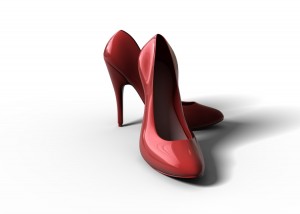Stiletto heels and other attire conundrums
 I belong to several etiquette and image groups on LinkedIn. I like being able to share ideas and resources and to ask questions of the group about various etiquette and attire topics. The last question I posed to a group I started – The Image and Etiquette Consultants group – was “What heel height constitutes a stiletto?” It sparked quite a discussion.
I belong to several etiquette and image groups on LinkedIn. I like being able to share ideas and resources and to ask questions of the group about various etiquette and attire topics. The last question I posed to a group I started – The Image and Etiquette Consultants group – was “What heel height constitutes a stiletto?” It sparked quite a discussion.
One member posted that a stiletto heel is not about how high it is, but rather it is a kind of heel – one that is long and thin and named after the stiletto dagger. She wrote that it can be anywhere from two to six inches tall. Other members weighed in that a stiletto heel has come to be known as a very tall heel.
When I give my First and Lasting Impressions training to corporations, I talk about professional attire dos and don’ts, including appropriate heel height. How we are dressed really does make a statement. Your heels can be an asset or a liability in the workplace, just like other clothing items can help or hurt your career.
So, what is an appropriate heel height for professional women? In the workplace, a women’s shoes should not have a heel that is taller than three and half inches. If you are short, and the heel is not thin and pointy, you could get away with a four inch heel. Anything taller than that and you look like you’re ready for a night on the town, not the workplace.
Here are a few more dos and don’ts:
Do wear clothing that fits well. Your clothes shouldn’t be tight or have any gaping. Avoid showing bumps and bulges. Also dodge items that are big and baggy.
I recently had to have a few pants altered. It wasn’t very expensive and it allowed me to still wear some nice clothes that I had invested in. There are great tailors throughout the city. If you have lost or gained some weight, see if your items can be altered to fit better before tossing them.
Don’t wear revealing clothing. Just say no to clothes that show off your cleavage, your midriff, your back, etc. Skirts or dresses should be no shorter than two inches above your knee. Also, always wear a sweater or jacket when wearing a sleeveless shirt. This especially applies to women who have many choices when it comes to sleeveless shirts – spaghetti straps, tank tops and sleeveless dresses.
Don’t dress too casually. People take us more seriously when we are dressed professionally. I have made the assumption a few times that when a business owner is dressed nicer than others her or his business is more successful. The same is true in the workplace. As the saying goes, dress for the job you want, not the one you have.
Many people have trouble knowing what too casual is. Here are the guidelines for appropriate business casual attire, which is the most common workplace dress code.
Men
• Dress shirts with or without a tie, alone or under a sweater vest, sweater, jacket or sport coat.
• Polo shirts or a casual button down shirt.
• Dress pants or nice khakis.
• Dress shoes or loafers.
Women
• Dress shirts, open collar shirts or sweaters, any of which can be worn under a jacket or cardigan.
• Khakis or dress pants.
• A modest dress or skirt (not too tight or shorter than two inches above the knee).
• Closed toe pumps in the fall and winter, sandals and peep toes in the summer, as long as your toenails and feet are nicely groomed.
A few items to avoid
• Sandals for men; some workplaces don’t allow women to wear sandals
• Jeans (unless you have a casual Friday dress code where jeans are acceptable)
• Shorts
• Tennis shoes
• Flip flops
• Baseball hats
However, if you work in the tech industry, you may be allowed to wear any of the above mentioned items. Usually though, those items are verboten in the workplace.
Mind the grooming. Be sure your shoes are shined, your hair is clean and combed, your clothes are pressed and your nails are clean and clipped. Women, if you wear nail polish, make sure it isn’t chipped. And, don’t forget the soap and deodorant. But do skip the heavy cologne or perfume.
When in doubt, consult your manager or HR department for guidance.
A few notes about interview attire.
Try to find out what the dress code is for the company you are interviewing with, and then dress a little nicer. For example; if it’s very casual company, wear a sport coat or jacket over a casual shirt with khakis. If the workplace adheres to business casual, wear a suit. A company with a more formal dress code – business attire – means you should wear your best suit and a quality tie for men. Women should wear understated jewelry and modest closed toe dress shoes with your pant or skirt suit.
Don’t wear cologne or perfume to an interview. Some people are sensitive to it.
We have many clothing choices today, but to succeed in the business world, choose just those items that make you look and feel like a professional.
Please note: We have a new method of delivering blog posts to your inbox. If you have previously received these blog posts through Feedburner, please subscribe to receive these blog posts through the form below and unsubscribe to the posts you receive through Feedburner.
One response to “Stiletto heels and other attire conundrums”
-
“… how high of a heel…” Lose the “of,” it’s grammatically incorrect.

 Sign up for the award-winning Clise Etiquette newsletter and receive a free chapter of Arden's book Spinach in Your Boss's Teeth.
Sign up for the award-winning Clise Etiquette newsletter and receive a free chapter of Arden's book Spinach in Your Boss's Teeth.
Leave a Comment